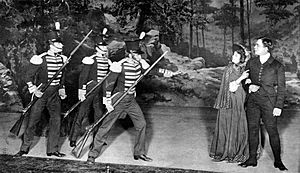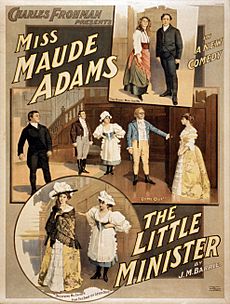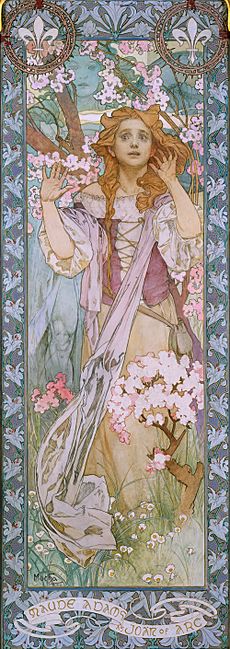Maude Adams facts for kids
Quick facts for kids
Maude Adams
|
|
|---|---|

Maude Adams, 1901
|
|
| Born |
Maude Ewing Adams Kiskadden
November 11, 1872 Salt Lake City, Utah, U.S.
|
| Died | July 17, 1953 (aged 80) Tannersville, New York, U.S.
|
| Occupation | Actress |
| Years active | 1880–1918, 1931–1934 |
| Signature | |
Maude Adams was a famous American actress born on November 11, 1872. She became very well-known for playing the character Peter Pan on Broadway in 1905. Her friendly personality made her very popular with audiences. At the peak of her career, she was one of the most successful and highest-paid performers. She earned over a million dollars a year, which was a huge amount of money back then!
Maude started acting when she was a small child. She often went on tour with her mother, who was also an actress. At age 16, she made her first appearance on Broadway. A theater manager named Charles Frohman helped her become a popular star. She often acted alongside a leading actor named John Drew Jr. in the early 1890s.
Starting in 1897, Maude Adams starred in many plays by J. M. Barrie, who later wrote Peter Pan. These plays included The Little Minister, Quality Street, What Every Woman Knows, and Peter Pan. These roles made her the most popular actress in America. After retiring for 13 years, she returned to act in more plays. Later, she taught acting at a college in Missouri. She then retired to upstate New York.
Contents
Maude Adams's Early Life and Career
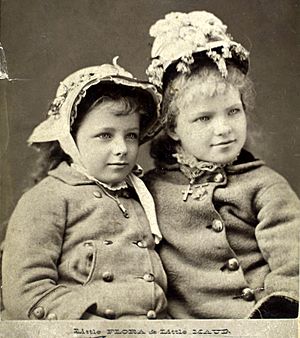
Maude Adams was born in Salt Lake City, Utah Territory. Her mother, Asaneth Ann "Annie" Adams, was an actress. Her father, James Henry Kiskadden, worked for a bank and in a mine. Maude's father died when she was young. Her family had Scottish roots. On her mother's side, her great-grandfather was an early Mormon pioneer.
Maude first appeared on stage when she was only two months old! She was in a play called The Lost Baby. She appeared again at nine months old, held in her mother's arms. Even though her father didn't want her to act, Maude started performing as a young child. She used her mother's maiden name, Adams, as her stage name. She toured with a theater group across the western U.S. They performed in small towns, mining areas, and some cities.
When she was five, Maude starred in two plays in San Francisco. At age nine, she lived with her grandmother and cousins in Salt Lake City. She studied at the Salt Lake Collegiate Institute. Maude later wrote about how gentle the people of Salt Lake City were. She also wrote about how hard it was to find her own personality while playing so many different characters as a child.
Becoming a Star on Broadway
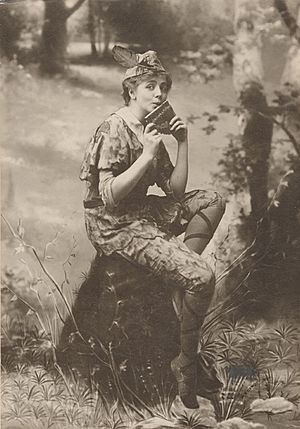
Maude Adams returned to New York City when she was 16. She appeared in a play called The Paymaster. She then joined a theater company in Boston. Soon after, she was on Broadway in Lord Chumley in 1888. Audiences started to notice her in a play called A Midnight Bell.
In 1889, a powerful producer named Charles Frohman offered her a contract. Frohman took charge of her career from then on. She quickly moved from child roles to leading parts. She often acted alongside her mother. In 1890, Frohman asked writers to create a special role for Maude in their new play, Men and Women. The next year, she appeared in The Lost Paradise.
In 1892, John Drew Jr., a very famous actor, joined Frohman's company. Frohman paired Maude Adams and John Drew Jr. in several plays. Their first play together was The Masked Ball. Critics praised Maude's acting for its charm and simplicity. In The Masked Ball, Maude's character pretended to be a little tipsy. This scene was so good that she received a two-minute standing ovation on opening night! Audiences loved her, and the play ran for 18 months.
Even though some plays after that were not as successful, Maude's career took off again in 1896 with Rosemary. This comedy was a big hit with both critics and audiences.
Barrie Plays and Huge Success
Charles Frohman wanted J. M. Barrie to turn his popular book The Little Minister into a play. Barrie thought no actress could play the main character, Lady Babbie. But after seeing Maude Adams in Rosemary, he knew she was perfect! The play opened in 1897 and was a huge success. It ran for 300 shows in New York and set a new record for ticket sales. This play made Maude Adams a true star.
Another play by Barrie, Peter Pan; or, The Boy Who Wouldn't Grow Up (1904), became the role Maude Adams is most remembered for. She was the very first actress to play Peter Pan on Broadway. Peter Pan opened in 1905 and had a very long run on Broadway. Maude played Peter Pan many times over the next ten years. The special collar she helped design for her Peter Pan costume became a popular fashion trend, known as the "Peter Pan collar".
Maude Adams also starred in other Barrie plays, like Quality Street (1901) and What Every Woman Knows (1908). She also played Juliet in Shakespeare's Romeo and Juliet in 1899. Audiences loved her in this role, even if some critics didn't. In 1909, she played Joan of Arc in a huge outdoor production at Harvard University.
In 1911, she appeared in another French play, Chantecler. This was the story of a rooster who believed his crowing made the sun rise. While critics had mixed feelings, audiences loved her. Maude later said this was her favorite role, with Peter Pan being a close second.
Later Years and Retirement
Maude Adams retired from acting in 1918 because she became very sick with influenza. During the 1920s, she worked with companies like General Electric to make better stage lighting. She also worked with Eastman Company to improve color photography. Some people think she did this because she wanted to appear in a color film version of Peter Pan.
After 13 years away from the stage, she returned to acting for a short time. She appeared in some Shakespeare plays, like The Merchant of Venice in 1931 and Twelfth Night in 1934.
Maude Adams was often described as a shy person. She was known for being very private. She was also known for sometimes helping her fellow actors by giving them money from her own pay. Once, a theater owner raised ticket prices very high because Maude Adams was so popular. Maude made the owner refund the extra money before she would go on stage. From 1937 to 1949, Maude Adams led the drama department at Stephens College in Missouri. She was known as an inspiring teacher.
After her final retirement, film producers sometimes tried to get her to act in movies. In 1938, a producer named David O. Selznick convinced her to do a screen test for a film. However, they couldn't agree on terms, and she didn't take the role.
Maude Adams passed away at her summer home in Tannersville, New York, when she was 80 years old. She is buried in the cemetery of the Sisters of the Cenacle in Lake Ronkonkoma, New York.
Broadway Appearances
- The Paymaster – 1888
- Lord Chumley – 1888
- A Midnight Bell – 1889
- Men and Women – 1890
- The Masked Ball – 1892
- The Butterflies – 1894
- The Bauble Shop – 1894
- The Imprudent Young Couple – 1895
- Christopher, Jr. – 1895
- The Squire of Dames – 1896
- Rosemary – 1896
- The Little Minister – 1897 and 1904
- Romeo and Juliet – 1899
- L'Aiglon – 1900
- Quality Street – 1901
- The Pretty Sister of Jose – 1903
- 'Op o' Me Thumb – 1905
- Peter Pan – 1905, 1906, 1912 and 1915
- Quality Street – 1908
- The Jesters – 1908
- The-Merry-Go-Round – 1908
- What Every Woman Knows – 1908
- Chantecler – 1911
- The Legend of Leonora – 1914
- The Little Minister – 1916
- A Kiss for Cinderella – 1916
Images for kids
-
Maude Adams as Phoebe in Quality Street (1901)
See also
 In Spanish: Maude Adams para niños
In Spanish: Maude Adams para niños


